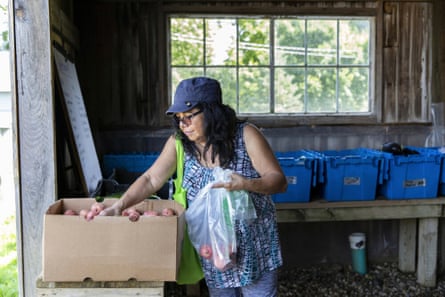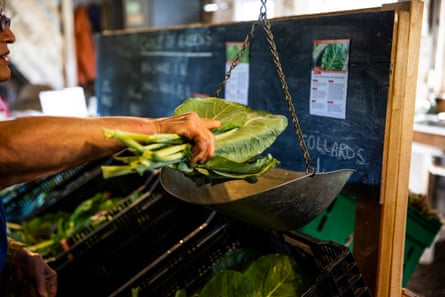Epretty Wednesday all through the growing season, Emilyn Sosa picks up a box of create from a local community center in Brooklyn crammed with the week’s harvest. This could incorporate carrots, beets or occasionally kohlrabi, which she cooks up into soups and salads for her relatives of five.
The cost? It’s whatever Sosa judges to be truthful. For a weekly box, the 33-12 months-aged pays about $15 (£12). If she have been to buy a very similar amount of fruit and greens at a regular supermarket – in which the prices are of study course non-negotiable – the price tag could be upward of $60 (£50) for every 7 days.
Sosa is a member of a neighborhood-supported agriculture (CSA) program known as Rock Continuous, a 12-acre farm in upstate New York. Customers like her make typical payments to acquire bundles of freshly harvested fruit and veggies. But the selling prices are determined on a sliding scale of income, permitting consumers to decide on a payment amount that is economical to them. Other current market farms throughout the US are opting for sliding-scale designs in an effort and hard work to attain a wider demographic of prospects and to help farmers remain afloat.
Sosa has no notion what her fellow members are electing to pay out. “And that would make this sort of a difference, to not experience like a charity,” she explained.
At Rock Steady, the once-a-year value for associates, dependent on their revenue, is break up into large ($1,155), center ($825) and decreased ($660) brackets. In the reduced bracket, that comes out to about $30 (£25) a 7 days, for about 8 or 9 items. The farm also accepts Snap and EBT playing cards, the federal nutrition system previously acknowledged as foods stamps. Most people today are in the middle bracket, although increased-income contributors subsidize people on the reduce conclusion of the scale.
When becoming a member of the program, clients are requested to choose an stock of their condition, equally materials and social, to identify how considerably to pay back: do you very own a property? Do you have a college education and learning? Do you have personal savings? People who do are asked to pay a greater share. People who have considerable financial debt or are leasing or are senior citizens are invited to fork out a lessen share.

A 2017 examine of approximately 500 CSA farm managers across the US found that 14{33c86113bcc32821f63c6372852a0f501e07fff55ce3ce61b15b246c5f8c531c} provided backed plans. A additional recent examine discovered more than 100 subsidized CSA programs.
Although Rock Continuous launched a subsidized product in 2015, the Covid pandemic was a turning point, claims co-founder Maggie Cheney, who works by using they/them pronouns. It was at the commencing of the pandemic, when traces for food items pantries and grocery suppliers snaked about New York Metropolis blocks, that larger-money customers of the CSA started providing extra so that all those with less suggests could find the money for it too, Cheney stated. Now the farm’s CSA is so oversubscribed it has a 200-strong waiting listing.
“It’s not a donation of our produce, which is not a sustainable route for farmers, who typically can’t even pay themselves,” states Cheney.
“As a queer-owned and -operated farm, social justice operates deep in our mission,” they increase. “What motivates us is feeding our group, which is composed of many lower-profits and marginalized individuals.”
Also in New York point out, but on the other side of the Hudson River, a CSA farm termed the Phillies Bridge Challenge presents a countrywide wage calculator to guideline members to aid them make a decision in which they sit on the sliding scale. Some shares are discounted by 70{33c86113bcc32821f63c6372852a0f501e07fff55ce3ce61b15b246c5f8c531c} for all those who are eligible for Snap, which arrives out to about $6 a week for a modest allowance of seasonal create.
Assistant farm supervisor Rhyston Mays, who works by using they/them pronouns, thinks it’s important to pay back one thing, even a marginal quantity. “Part of our honor process is developing a framework for men and women to be ready to self-pick and have company as a man or woman who participates in the foods system,” they say.
A research of 41 CSAs in California discovered that even when having to pay entire selling price, minimal-earnings subscribers were usually far more committed to the software than these with better incomes. Those people with once-a-year earnings underneath $50,000 (£41,371) have been a lot more enthusiastic to share monetary danger, volunteer and take part in farm occasions than those with larger incomes.

Subsidizing make is still only one remedy to the difficulty of lowering foodstuff inequalities, suggests Matt Kauffman, the founder of 5 Loaves, an urban farm in Buffalo that delivers sliding-scale shares. “Just generating broccoli out there doesn’t indicate persons are heading to consume broccoli,” he claims. “There are cultural disconnects at participate in.”
This is one particular of the downsides that Marilyn Sitaker, an epidemiologist and public wellness researcher, has determined with sliding-scale designs. “Food obtain goes far outside of affordability,” she suggests. Develop needs to be considerable, easy to decide on up, culturally acceptable and suited to the customer’s preferences. “The CSA design needs willingness to make a determination. It’s not for absolutely everyone,” she provides.
For this purpose, 5 Loaves runs instruction courses, these as cooking lessons and agricultural internships, to give communities the applications to appreciate clean produce. In Buffalo, a town with a assorted refugee and immigrant neighborhood, “maybe persons want these specific eggplants from Thailand or crops from east Africa,” Kaufmann states. As the Buffalo farm grows, it is starting to sow seeds from its members’ cultures.
Communities can be knitted alongside one another by “investing in the risk or reward of community agriculture”, claims Colleen Dixon, a director at Zenger Farm in Portland, Oregon, which gives sliding-scale payments and operates far more like a farmers’ market place. In its place of dispatching containers of create, the fruit and vegetables are laid out on extensive tables each individual week from which CSA associates are invited to decide on a established variety of products.
But there are challenges connected with CSAs, for illustration if a farm fails to create plenty of crops. “Some weeks we have substantial harvests, but other individuals it is hundreds of kilos of tomatoes and not significantly else,” Dixon claims. When this comes about, Zenger Farm gives refunds to lower-cash flow subscribers so they can supply their staple foodstuff in other places.
Serious climate can also disrupt crops. “If we have a snowstorm, drought or fires, it definitely shortens the rising season, which impacts meals manufacturing,” Dixon says. “I assume we’ll see extra of these issues with weather alter.”
These CSA plans are much ahead of federal and condition governments, Sitaker states. A nationwide food items method to fund systems that will take away limitations to neighborhood foods obtain is only launching up coming calendar year.
But Sitaker believes sliding-scale designs could have “a compact but mighty” function to enjoy in addressing food stuff inequities with greater federal government investment decision.





More Stories
Hanco’s: Bringing the Flavors of Vietnam to Brooklyn
TropiBowls Bring Healthy Food to Tamarac • Tamarac Talk
How can we make our brains prefer healthy food? – study